Scroll to:
Reduction of Watercrafts Vibroacoustic Activity by Vibration Damping Materials
https://doi.org/10.23947/2541-9129-2023-1-28-38
Full Text:
Abstract
Introduction. Electric machines, diesel installations, pumping units and fans, as well as working bodies of dredgers (pipelines, scoops, rippers, etc.) are the main sources of noise and vibration on watercrafts. Moreover, the main harmful factors in the operation of floating cranes and dredgers are both the vibration itself and the accompanying phenomena of infrasound and structural noise. One of the most urgent tasks for the introduction of technosphere safety methods on watercrafts is to reduce the harmful effects of vibroacoustic factors on the health of personnel.
The research objective is to improve the working conditions of watercrafts drivers by introducing the method of designing vibration protection systems proposed by the authors, taking into account both the external factors (ambient temperature) and the dynamic characteristics of vibration damping materials.
The possibility of choosing the most rational vibration damping material based on the engineering calculation of the required vibration insulation is shown.
Materials and Methods. A passive method of vibration control has been applied, in which elastic elements and vibration damping material are used in the watercraft design. The sources of noise and vibration have been identified, and their actual exposure levels have been determined. The analysis of dynamic characteristics and properties of vibration damping materials is carried out. The factors influencing the efficiency of vibration damping are revealed.
Results. A design scheme of the vibration damping model at the workplace of the watercraft driver has been developed. An analytical database of dynamic characteristics and properties of vibration damping materials has been created. An engineering method for calculating the effectiveness of vibration insulation has been adapted to watercrafts. The calculations of the effectiveness of vibration insulation using various vibration damping materials of different thicknesses have been performed, on the basis of which the advantages of vibration damping flooring made of elastomeric plate VEP20 have been proved.
Discussion and Conclusion. The engineering methodology developed in Excel for calculating the effectiveness of vibration insulation is automated and has a user-friendly interface. This allows you to calculate and reasonably select multilayer structures taking into account the ambient temperature, as well as the dynamic characteristics of vibration damping materials depending on the spectrum of noise and vibration. The results obtained can be used in the design of vibration protection systems for watercraft drivers.
Keywords
For citations:
Budovskiy A.V., Bulygin Yu.I., Pavlikov A.V., Tryukhan A.V. Reduction of Watercrafts Vibroacoustic Activity by Vibration Damping Materials. Safety of Technogenic and Natural Systems. 2023;(1):28-38. https://doi.org/10.23947/2541-9129-2023-1-28-38
Introduction. The difficulty of determining the optimal level of vibration insulation is associated with the identification of sources of vibroacoustic activity and depends on the watercraft design features. In addition, the effectiveness of vibration insulation depends on the dynamic properties of vibration damping materials themselves. In turn, the dynamic characteristics of vibration damping materials are influenced by environmental conditions (temperature) and vibration spectra.
In order to reduce the watercrafts vibroacoustic activity, it is necessary to solve a set of interrelated tasks:
– to identify the main sources of noise and vibration, as well as their actual exposure levels;
– to develop vibration damping models and design schemes for vibration protection system of the watercraft driver at the workplace;
– to conduct an analytical review of scientific research on the determination of the dynamic characteristics of materials that affect the effectiveness of vibration damping;
– to determine the exact dynamic characteristics of vibration damping materials, including the coefficient of loss of vibrational energy, taking into account the spectrum of vibrations and temperature1.
The solution to the above tasks will allow us to propose a reasonable methodology for the engineering calculation of vibration insulation based on vibration-damping materials, taking into account the specifics of the object of study.
Materials and Methods. To reduce vibration levels, methods of vibroacoustic protection of the watercraft driver were used. They consisted in the use of an elastic damping element in the design under development.
A dredger for mining operations was selected as the object of research — a floating dredging unit PZU-8M (Fig. 1). It is used by KT "Krym-Investstroy and Company" during the development of the Sasyk sand-gravel mixture deposit in the Crimea River. In machines of this type, the source of noise and vibration is the equipment mounted on pontoons (Fig. 1).
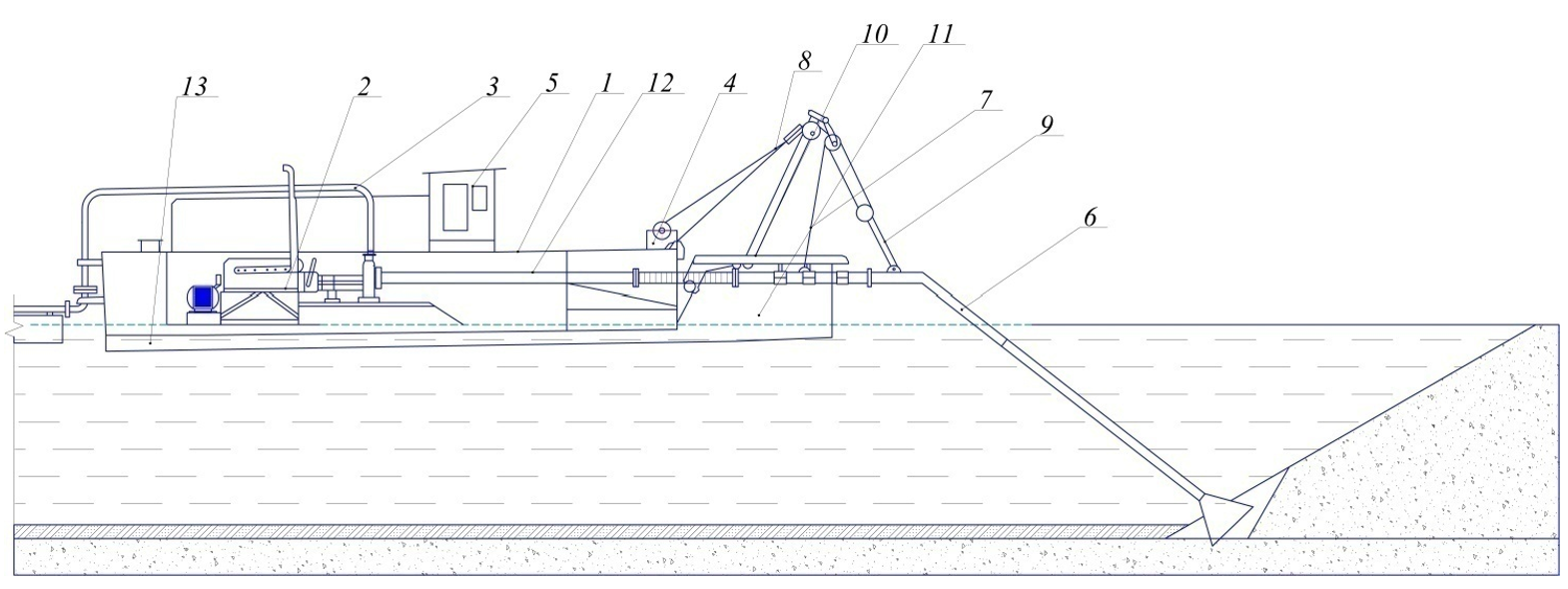
Fig. 1. Diagram of the PZU-8M floating dredging unit: 1 — body; 2 — 3D6SN engine; 3 — dredging pipe; 4 — hoist winch of the ripper frame; 5 — control cabin; 6 — suction pipe; 7 — jib boom; 8 — suspension of the jib boom; 9 — tackle pulley of the suspension of the suction pipe frame; 10 — lifting frame of the ripper; 11 — side pontoon; 12 — pressure pipeline; 13 — central pontoon
There is a problem of obtaining reliable information about noise and vibration levels on this equipment. Often, these data may be found in the protocols of the results of a special assessment of working conditions (SAWC) or in special literature (guidance document, GOST), as well as in scientific and technical literature (dissertations, articles, reports)2 [1, 2]. However, the degree of their reliability varies, which necessitates planning and conducting noise and vibrations measurements directly on the object.
For example, the actual noise levels of the 3D6SN diesel pump installed on the PZU-8M dredger platform are given in the guidance document3 and shown in Figure 2.
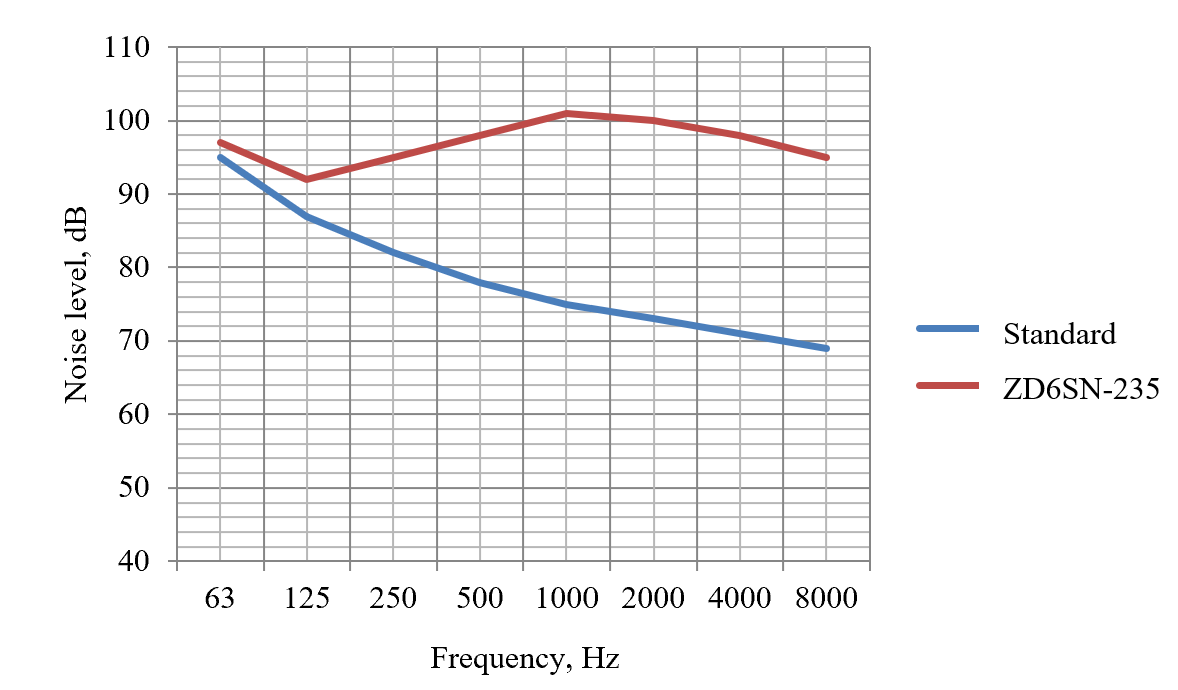
Fig. 2. Comparison of the actual sound pressure level of the diesel pump ZD6SN with the sanitary and hygienic norms4
Judging by the data in Figure 2, the required noise insulation reaches 26 dB at a frequency of 1000 Hz, which is one of the reasons for the high levels of noise and vibration transmitted from the diesel pump to the driver's cabin.
In the case under consideration, KT "Krym-Investstroy and Company" provided the authors with the protocols with the results of measurements of sound pressure and vibration acceleration levels at the workplace, which were obtained as part of SAWC conducted in the organization in March-April 2017. Since the measurement protocols present equivalent noise levels measured three times in accordance with the method, it is necessary to decompose the sound pressure level into the spectrum according to Osipov5 to obtain a complete spectral noise characteristic.
As a result of the analysis of the protocol data on noise and vibration levels, spectral noise characteristics were obtained (Fig. 3). These values of the actual sound pressure levels at the workplaces of the driver and the assistant driver of the PZU-8M dredger revealed an excess of sanitary and hygienic standards, which corresponded to 3.2 harmful class of working conditions. The actual values of the vibration parameter corresponded to 3.1 class of working conditions, and an excess of 6.3 dB over the adjusted levels was also found (Fig. 4).
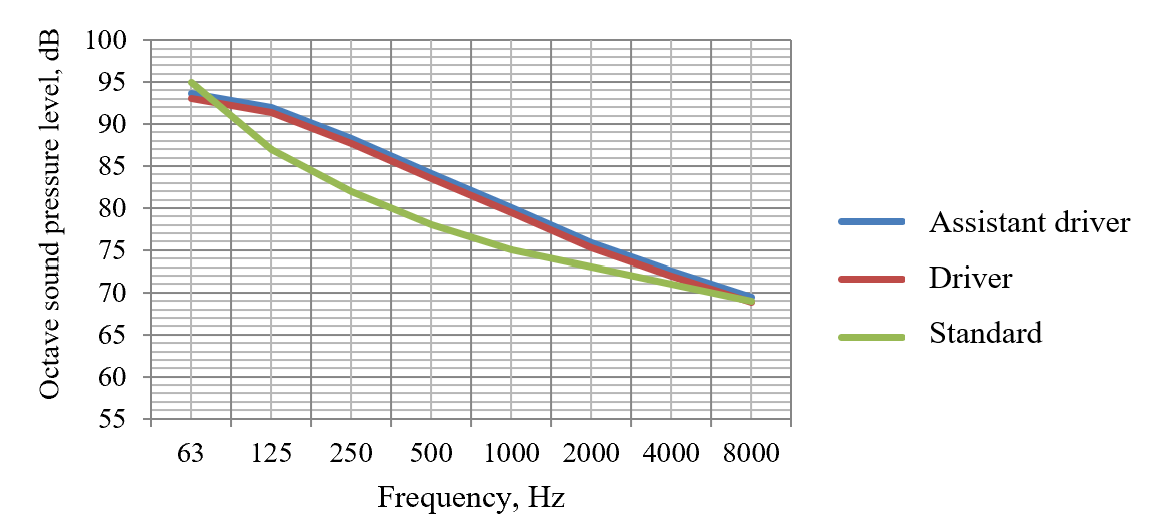
Fig. 3. SAWC results of the dredger driver and the driver assistant on the noise factor (Authors’ figure)
Thus, in the future, we will consider reliable sound pressure and vibration acceleration levels measured by the device "Noise meter-vibrometer "Ecofizika 110A" in accordance with the methodology4 in the SAWC framework, (Fig. 3, 4).
Means of protection against vibration and noise can affect the excitation source itself or on the path of its propagation. It is necessary to try to implement technical solutions for noise and vibration protection at the design stage of machines. When this is not done, you have to do it already at the operational stage.
Vibration damping (vibration-absorbing) coatings are among the means of protection against vibration and noise transmitted to the dredger driver's cabin. Their main purpose is to reduce the vibroacoustic activity of noise and vibration sources.
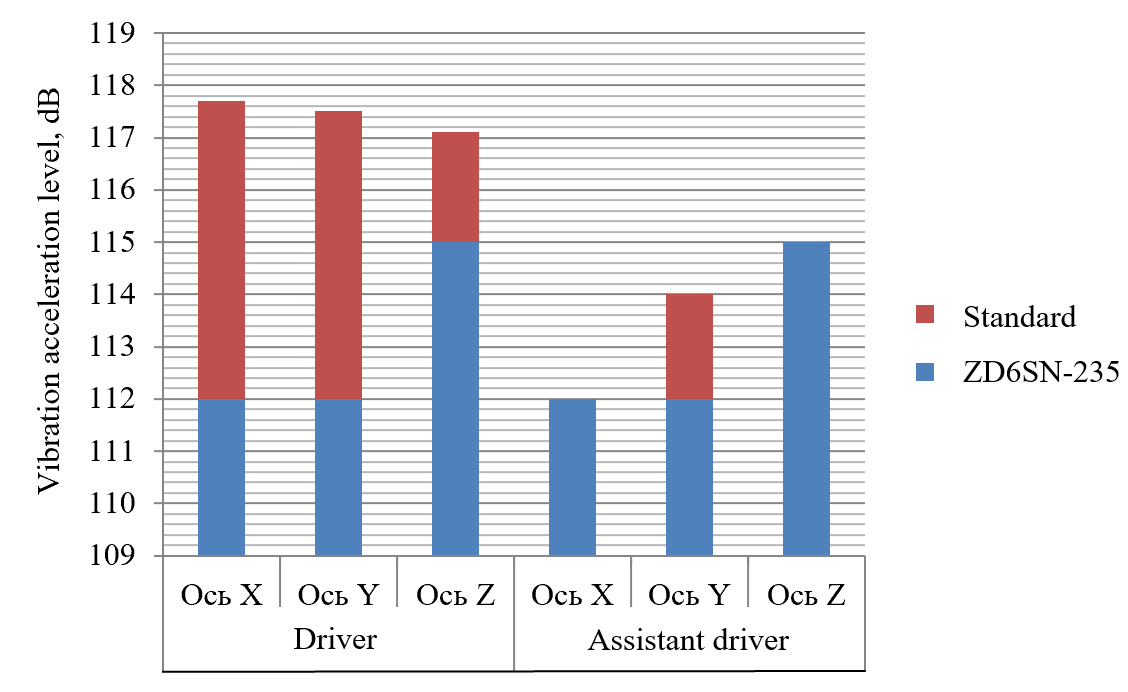
Fig. 4. SAWC results of the dredger driver and the driver assistant on the vibration factor
Results. Design scheme of the vibration damping model. Figure 5 shows the design scheme of the vibration damping system at the workplace of the dredger operator. Since the mass of the vibration damping mat mП is small in comparison with the mass of the platfor m m1, the influence of its movement on the vibrations of the platform is neglected. The main structure with a mass of m1 does not rely on vibration insulators with reduced rigidity. In addition, we do not take into account the effect on vibration insulation of vibrations from water. Vibration dampener (mat) is connected to the main mass by vibration insulators with reduced stiffness С2 and dampers with reduced viscous resistance drag coefficient r.
The design scheme of the vibration damping system at the workplace of the dredger operator is described analytically by a system of differential equations (1)–(3) (Fig. 5).
According to this design scheme, the following relations of the parameters involved in the model equations are valid:

where Е — modulus of elasticity, Pa; µ — Poisson's ratio; mч — mass of a person (driver), kg; — total coefficient of loss of vibrational energy; — external force of influence, N.
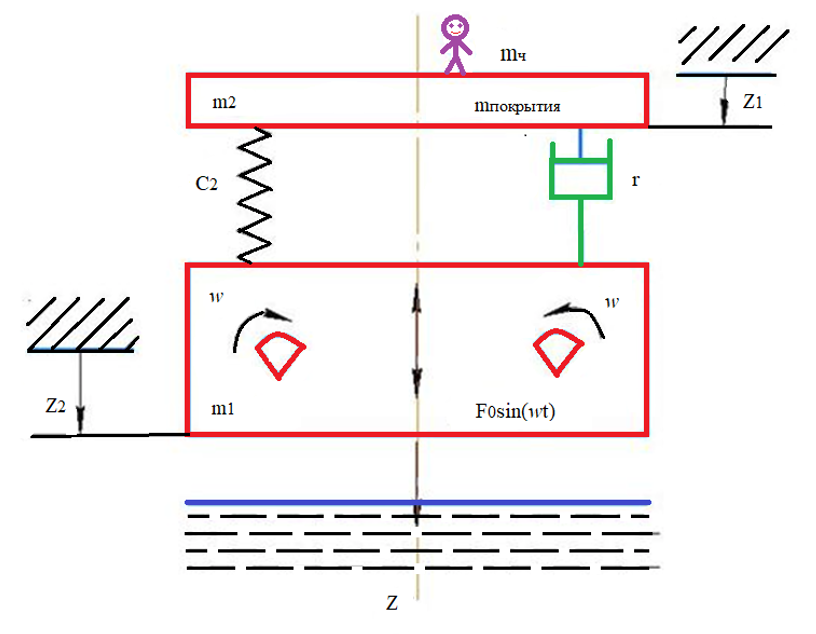
Fig. 5. Design scheme of the vibration damping system at the dredger operator workplace
Differential equations of motion have the form:

where , — vibration displacement of the platform and vibration damping flooring, m; — amplitude of the external disturbing force, N; — circular rotation frequency, rad/s.
System of differential equations (2) and (3) can subsequently be solved both analytically and numerically.
However, for the purposes of engineering calculation, it seems to the authors that simplified dependencies are quite acceptable when there is no need to accurately determine the vibration damping parameters.
Algorithm for calculating the vibration insulation effectiveness. The efficiency of vibration damping in structures and structural elements is determined through the coefficient of loss η, which is characterized by the ratio of the energy absorbed in the system during the oscillation cycle (Wпогл) to the maximum potential energy in the system (Wпот):

To calculate the efficiency of vibration damping flooring at the workplace of the PZU-8M dredger operator, we use the coefficient of loss of vibrational energy, which is determined for a single-layer structure by formula6:

where Е1 and Е2 — elastic modulus of steel tubular platform and vibration damping flooring, Pa; η1 and η2 — effective coefficients of vibrational energy losses of steel and flooring; h1 and h2 — thickness of the steel sheet of the platform and vibration damping flooring, mm; 1 and 2 — Poisson’s ratios of steel and flooring material.
The calculated decrease in octave sound pressure levels is determined by formula:

where ηосновн=ηплтаформы=10-4.
Analytical base of dynamic characteristics and properties of vibration damping materials. The difficulty of determining the coefficient of loss of vibrational energy of materials η is due to the absence of proven dependences η on temperature T and on the frequency spectrum f in the literature. Only in source1 there is some information about the dynamic characteristics of some materials and substances. The analysis of the scientific literature shows that there is also a limited number of dissertation studies on this issue, for example, in [3] only the features of vibration damping materials used in construction are considered. The lack of sufficient information about the spectrum of dynamic characteristics of vibration damping materials makes it necessary to plan experimental studies in the future to determine η. At this stage of the study, as a result of the analysis of available literature sources, the dynamic characteristics of some materials used as vibration-insulating flooring in workplaces were collected and presented in Table 1 [4–7].
Let us calculate the expected reduction of noise and vibration levels at the workplace of the dredger operator depending on the thickness of the damping elements according to formulas (4)–(6). From the reference data for steel, we have: Е1=2∙1011 Pa, η1=10-4, µ1=0.28, the thickness of the steel sheet covering the dredger platform is h1=1.5 mm. Dynamic characteristics of vibration damping materials are selected from Table 1. Figure 6 provides the calculation results. The analysis of the values calculated using formula (6) of the expected decrease in sound pressure levels and vibration acceleration when using vibration damping materials allowed us to draw a number of conclusions.
Table 1
Fragment of the created database of dynamic characteristics of vibration damping materials
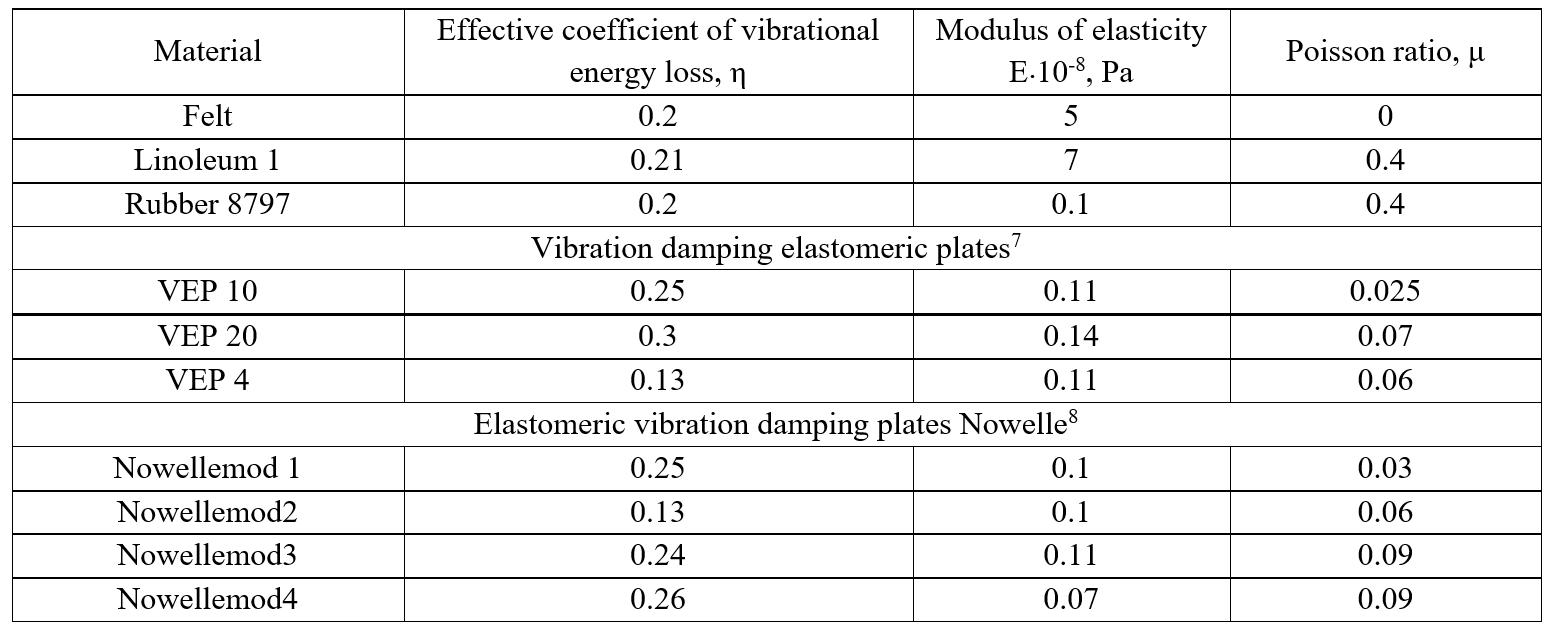
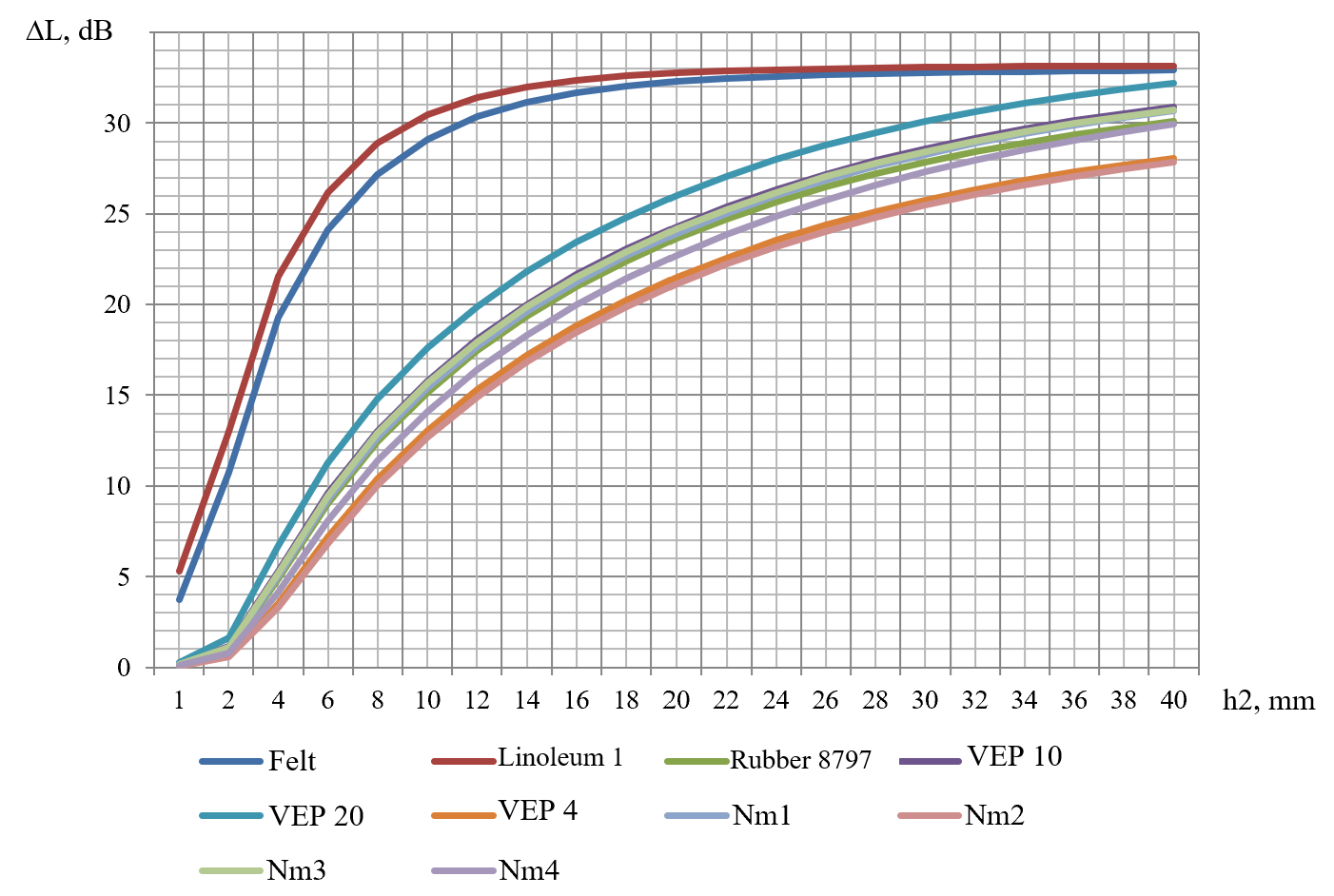
Fig. 6. Graph of the dependence of sound pressure level decrease on vibration damping material thickness h2, mm
Materials such as felt and linoleum 1, with a relatively small coating thickness (up to 40 mm), provide more effective noise and vibration insulation compared to other materials. However, in the future, an increase in the thickness of non-rubber coating (from 40 to 60 mm and above) does not affect the effectiveness of workplace insulation (Fig. 7).
On the contrary, the results of calculation of the vibration damping efficiency show that with a coating thickness of more than 49 mm, the efficiency of materials made of elastomeric plate VEP20 increases and continues to grow, compared with materials such as felt and linoleum (Fig. 7). Moreover, with a thickness of vibration damping flooring VEP20 h2=4 mm, a decrease in sound pressure and vibration acceleration levels is achieved up to sanitary and hygienic standards.
Thus, the calculations of the effectiveness of vibration insulation when using various vibration damping materials of different thicknesses have shown the advantages of vibration damping flooring made of elastomeric plate VEP20 compared with other materials.
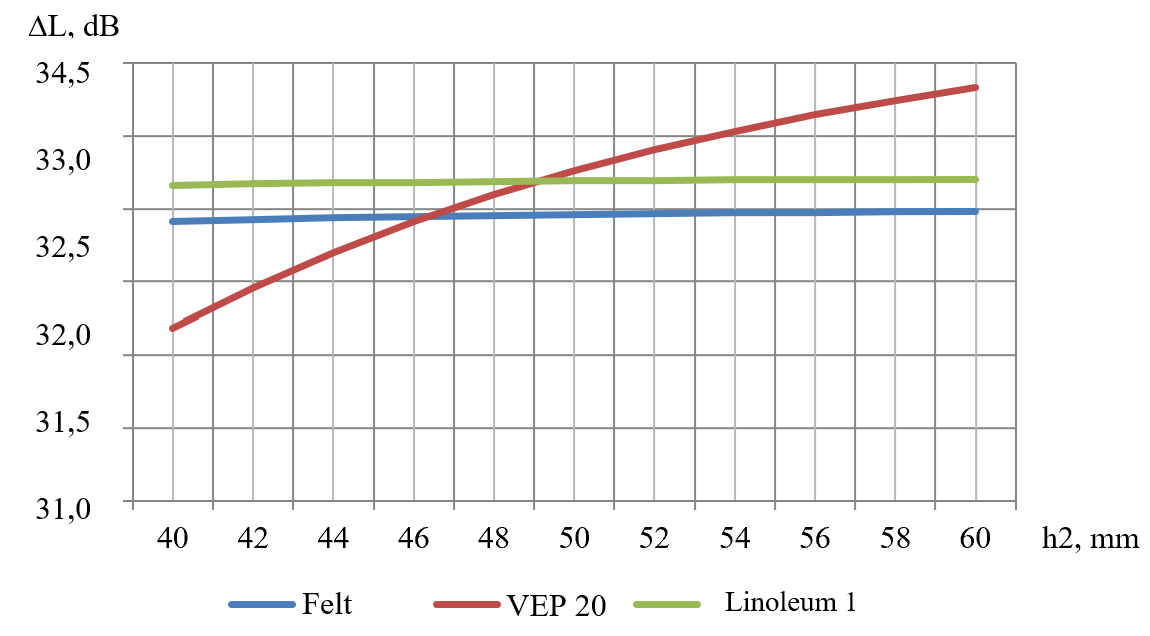
Fig. 7. Comparison of the effectiveness of sound pressure levels reduction due to vibration damping of the dredger platform with a rubber plate, felt and linoleum1, where h2 is the vibration damping flooring thickness, mm
Significance of vibration damping materials properties. It should be noted that the above calculation of vibration and noise insulation is made for a special case when the dynamic characteristics do not change from temperature, noise and vibration spectrum. In real operating conditions, under the influence of external temperature and the frequency spectrum of vibrations, the values of dynamic elastic modulus and vibrational energy loss coefficients of damping materials change significantly, which, in turn, are determined by their chemical structure and molecular mobility, intra- and intermolecular interaction.
It follows from dependence (7) that at low ambient temperatures (below 0 °C), polymers are in a glassy state, which means that their dynamic elastic modulus reaches a value of 109 Pa. Conversely, at high temperatures (28 °C and above), when polymer materials are in a highly elastic state, the values of elastic modulus decrease to 105––106 Pa.
The effective coefficient of loss of vibrational energy of polymers depends on the value:

where τ1 — relaxation time; Т — oscillation period.
The value of the effective loss coefficient of the polymer directly depends on its temperature. For this reason, its value will increase with decreasing ambient temperature. At low temperatures, the polymer material behaves in the same way as at high oscillation frequencies. With an increase in temperature or with a decrease in frequency, ωТi decreases, the loss of vibrational energy first increases, then, after passing through the maximum (at ωТi=1), decreases.
At high ambient temperatures or at low frequencies, the modulus of elasticity and the effective loss coefficient are quite small.
Conducting experimental studies of the dynamic characteristics of vibration damping materials is of great importance in the design of integrated protection systems for watercraft drivers [8–9]. Thus, in the absence or insufficient efficiency of microclimate normalization systems in the watercraft cabin, it is possible to worsen the damping properties of materials and the effectiveness of vibration damping of the coating (flooring, mat), which is under the influence of temperatures in either a heating or cooling microclimate9[10].
Automation of the engineering methodology for calculating the effectiveness of vibration insulation by means of Excel. To quickly change and select the main parameters of the vibration damping coating, a control program was developed in Microsoft Excel (Fig. 8, 9). Based on the database of dynamic characteristics of vibration damping materials, the program automatically determines the total coefficient of vibrational energy loss of all flooring layers, as well as a decrease in the sound pressure level.
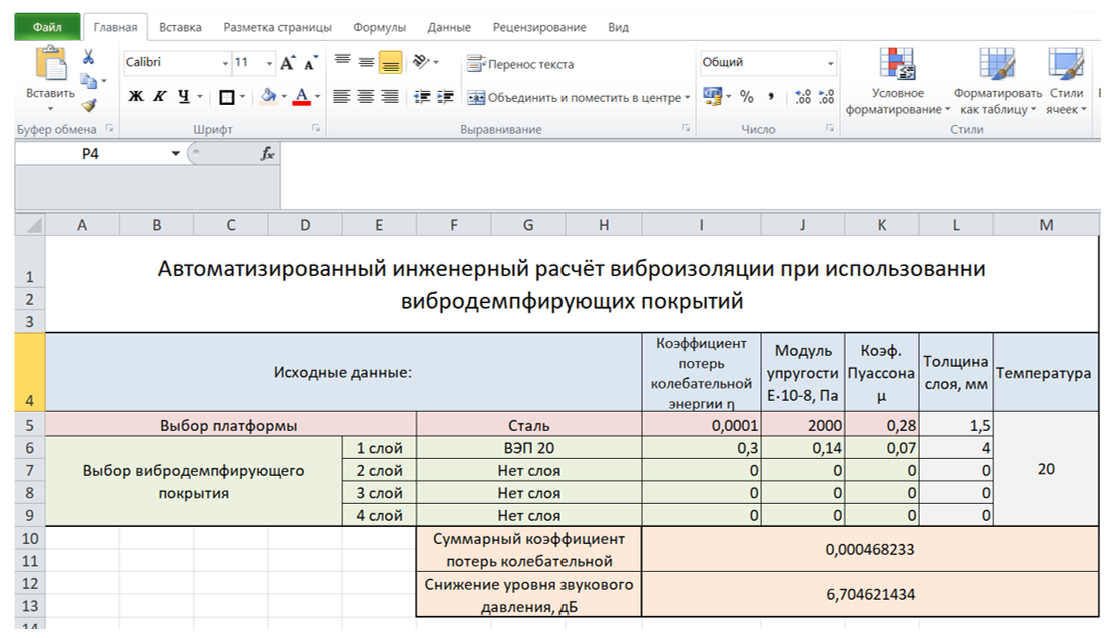
Fig. 8. Interface of the program for automated calculation of vibration insulation efficiency in MS Excel
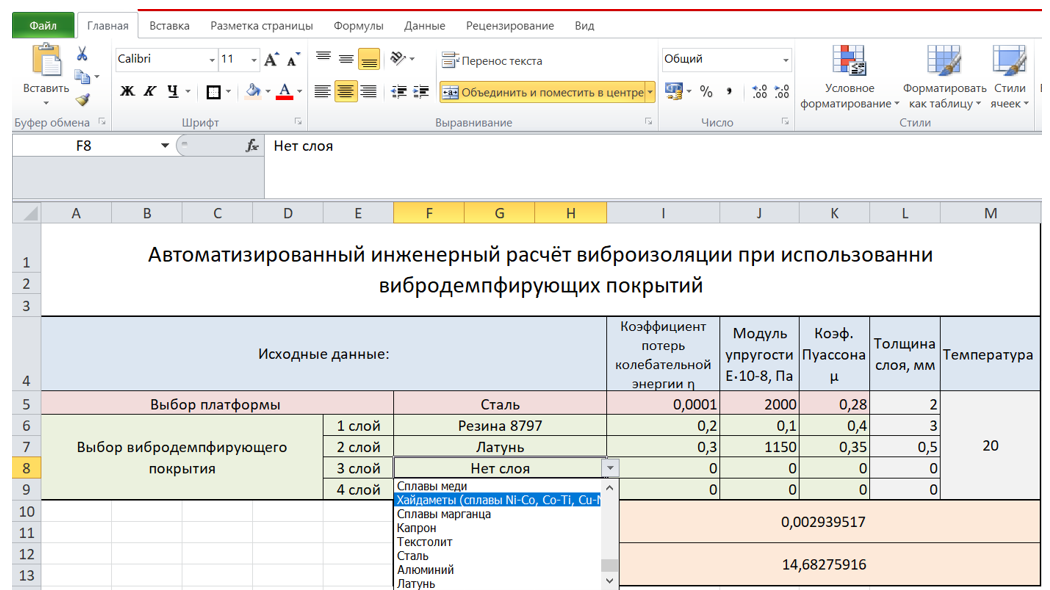
Fig. 9. Use of vibration damping materials database in the design of vibration protection in MS Excel
At the initial stage of preparation for the calculation, the operator must have the following data: the number of flooring layers (the maximum number is 4), the thickness of each layer, the temperature of the medium. Further, by selecting the material of each layer, the vibration protection designer achieves the maximum reduction in the sound pressure level at the specified parameters.
Discussion and Conclusion. The authors have automated the calculations of vibration insulation efficiency in Excel. The calculation module of the above program is provided with data from the analytical database of dynamic characteristics and properties of vibration damping materials, which is easily replenished. This allows you to calculate and reasonably select multilayer structures taking into account the ambient temperature, as well as the dynamic characteristics of vibration damping materials depending on the spectrum of noise and vibration. The method of calculation and selection of vibration damping material for vibration protection systems of the driver proposed by the authors can be used not only at the design stage of new watercrafts, but also during the operation of the existing structures.
1Avdonin V. V. Vibropogloshchayushchie kompozitsionnye pokrytiya. Dissertation. Saransk, 2015. 123 p. (In Russ.).
2Shcherbakova O. V. Vibroizolyatsiya strukturnogo shuma na sudakh. Dissertation. Novosibirsk, 2014. 20 p. (In Russ.).
3RD 31.81.81-90. Rekomendatsii po snizheniyu shuma na sudakh morskogo flota. Approved by the decision of the Ministry of the Maritime Fleet and the Ministry of Justice of 04.04.1991. Leningrad, 1991. 67 p. (In Russ.).
4On approval of the Methodology for conducting a special assessment of working conditions, the Classifier of harmful and (or) hazardous production factors, the report form for conducting a special assessment of working conditions and instructions for completing it: Order of the Ministry of Labor and Social Protection of the Russian Federation No. 33n of January 24, 2014. Available from: https://www.consultant.ru/document/cons_doc_LAW_158398/ (accessed 15.02.2023). (In Russ.).
5Osipov G. L. (Ed.) Zvukoizolyatsiya i zvukopogloshchenie. Textbook. Moscow: Astrel', 2004. 450 p. (In Russ.).
6Chukarin A. N. Vibroakusticheskie osnovy rascheta metallorezhushchikh stankov na stadii ikh proektirovaniya. Dissertation. Rostov-on-Don, 1995. 29 p. (In Russ.).
7Vibrogasyashchie elastomernye plastiny. TU 2534-002-61734928-2013. Electronic fund of legal and regulatory documents. Available from: https://docs.cntd.ru/document/437156319 (accessed 15.02.2023). (In Russ.).
8Elastomernye vibrodempfiruyushchie plastiny Nowelle. TU 2534-001-32461352-2015. Electronic fund of legal and regulatory documents. Available from: https://docs.cntd.ru/document/437156318 (accessed 15.02.2023). (In Russ.).
9Maslenskiy V. V. Uluchshenie uslovii truda operatorov tekhnologicheskikh i mobil'nykh mashin v usloviyakh nagrevayushchego mikroklimata. Author’s thesis. Rostov-on-Don, 2021. 20 p. (In Russ.).
References
1. Егельская, Е. В. Влияние виброакустических характеристик силовых установок на уровни шума в кабинах плавучих кранов / Е. В. Егельская, А. В. Короткий // Вестник Донского государственного технического университета. — 2012. — Т. 16, № 1–2 (62). — С. 33–37.
2. Щербакова, О. В. Исследование требований санитарных норм, предъявляемых к вибрации и шуму на речном транспорте / О. В. Щербакова, М. К. Романченко // Вестник государственного университета морского и речного флота им. адмирала С. О. Макарова. — 2010. — № 1. — С. 70–73.
3. Смирнов, В. А. Сравнительный анализ динамических характеристик эластичных пластмасс и резиновых вибродемпфирующих материалов / В. А. Смирнов, М. Ю. Смоляков // Строительные материалы. — 2018. — № 6. — С. 36–40.
4. Кирпичников, В. Ю. Высокоэффективные средства низкочастотного вибродемпфирования с упругим элементом из полимерной пленки / В. Ю. Кирпичников, А. И. Святковский, Ю. Ф. Шлемов // Судостроение. — 2020. — № 1 (848). — С. 44–47.
5. Защита РЭА от механических воздействий путем вибродемпфирования несущих конструкций и сопутствующие этому негативные факторы / П. Н. Володин [и др.] // Робототехника и системный анализ : сб. статей. Т. 1. — Пенза : Пензенский государственный технологический университет, 2015. — С. 86–89.
6. Лесняк, А. Н. К вопросу об эффективности применения вибродемпфирующих покрытий / А. Н. Лесняк, А. А. Пшеницын, А. Ю. Спиридонов // Судостроение. — 2015. — № 3 (820). — С. 39–41.
7. Скрипченко, Д. С. Методика проведения испытаний по определению динамического модуля упругости, динамического модуля сдвига и коэффициента потерь звукоизоляционных материалов / Д. С. Скрипченко, С. Н. Овсянников // Строительные материалы. — 2017. — № 6. — С. 55–58.
8. Yaitskov, I. A. Theoretical research of noise and vibration spectra in cabins of locomotive and diesel shunting locomotive / I. A. Yaitskov, A. N. Chukarin, T. A. Finotchenko // International Journal of Applied Engineering Research. — 2017. — Vol. 12, No. 21. — Р. 10724–10730.
9. Основные аспекты оценки виброакустических факторов / Н. Х. Абдрахманов [и др.] // Безопасность техногенных и природных систем. — 2021. — № 3. — С. 13–22.
10. Elements of microclimate normalization system in the cabin of TORUM grain mandy combine/ B. Meskhi, Yu. Bulygin, E. Shchekina, V. Maslensky // IOP Conference Series: Earth and Environmental Science. — 2019. — Vol. 403. — Article 012089. doi: 10.1088/1755-1315/403/1/012089
About the Authors
A. V. BudovskiyRussian Federation
Aleksandr V. Budovskiy
1, Gagarin Sq.
Rostov-on-Don
Yu. I. Bulygin
Russian Federation
Yuriy I. Bulygin
1, Gagarin Sq.
Rostov-on-Don
A. V. Pavlikov
Russian Federation
Aleksandr V. Pavlikov
1, Gagarin Sq.
Rostov-on-Don
A. V. Tryukhan
Russian Federation
Aleksandr V. Tryukhan
1, Gagarin Sq.
Rostov-on-Don
Review
For citations:
Budovskiy A.V., Bulygin Yu.I., Pavlikov A.V., Tryukhan A.V. Reduction of Watercrafts Vibroacoustic Activity by Vibration Damping Materials. Safety of Technogenic and Natural Systems. 2023;(1):28-38. https://doi.org/10.23947/2541-9129-2023-1-28-38































